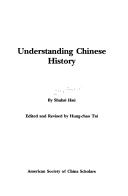Check nearby libraries
Buy this book

A traditional mainline ethnic Han dynastic view of Chinese history.
Check nearby libraries
Buy this book

Previews available in: English
Subjects
History, Civilization, Philosophy| Edition | Availability |
|---|---|
|
1
Understanding Chinese History
January 2004, American Society of China Scholars
Hardcover
in English
0975417800 9780975417805
|
aaaa
Libraries near you:
WorldCat
|
Book Details
First Sentence
"From the editor's preface: "This book is addressed to readers in the West.""
Edition Notes
Understanding Chinese History is a traditional dynastic history of China. It accepts the ethnocentric Han version of the Chinese experience, even to the point of referring to non-Han peoples as racially distinct. Additionally the outdated time-frame for the early dynasties is retained, and the Zhou is referred to as a feudal state. Moreover, the book is riddled with errors in English vocabulary, a fault which would be forgivable only if the book were not published in the U.S.
There are major issues with accepting the traditional history and historiography of China. Their focus on the usual main-line (ethnically Han) dynasties as a frame of reference, with the other entities in what now comprises China being relegated to subservient or non-civilized status, glosses over their substantial contributions to the history and culture of China. This also results in major historical events and time-periods of Chinese history being regarded as exceptions to the general thrust of Chinese history. As examples, the Mongolian Empire (the largest empire in world history), with the resulting Yuan Dynasty, is designated an “accidental empire”, the Tang Dynasty is subtly downgraded due to its mixed ethnic origins and orientation, and the Qing Dynasty is regarded as non-Chinese. Taken as a body, the periods of time dominated by non-Han ethnic groups give the lie to a Han perspective of Chinese history. In fact, one might question whether there was ever a truly “Han” Chinese dynasty. The origins of the Shang are cloudy, The Zhou were originally an ethnic group arising to the west of China, the founders of the Han were Chu, The Tang was ethnically mixed, the Song never controlled all of China, the Yuan was Mongol, the Ming founder was a peasant with uncertain background, and the Qing were Manchu. The author even states that current-day China is more than 90% Han, stretching the definition beyond any meaningful limits.
One can focus on four of the major issues arising from traditional histories of China:
1. There has been considerable debate on the nature of the Zhou Dynasty, but even the more rigidly oriented historians have come to accept the growing bureaucratic nature of the Zhou state. Using western terms, such as feudal to define Chinese organization during this period are fraught with pitfalls and frequently lead to highly erroneous conclusions.
2. The period following the overthrow of the Han Dynasty and the collapse of the Three Kingdoms is regarded by the author as a period of disunion, even going as far as suggesting it qualifies as a “dark age in Chinese history”. Contrary to this view, the period of the Sixteen Kingdoms and the Northern and Southern Dynasties was a time of extraordinary change and growth in Chinese history: increased contact with the world outside of China, significant growth and diversification of literary culture, and the introduction of Buddhism to, and Daoism in China. Along with the geographic shift and redefinition of China, these permanently altered the landscape, resulting in a very changed China going into the reunion of the Sui Dynasty.
3. The cosmopolitan nature of so-called periods of disunion, along with the Tang, Yuan and early Qing Dynasties represent periods of growth in not only the geographic entity of China, but in its world perspective. The opportunities presented to China during these periods, and missed by inward-looking dynasties (e.g., the Song) are neglected by traditional perspectives.
Finally, 4. Throughout Chinese history, there has been a leadership focus on cults of personality, whether in the form of emperors or paramount leaders. Certainly, this has also been present in many Western states, but in China it has been present to an extreme seldom seen in the West. The demise of such leaders usually resulted in major disruption to the polity. This issue needs more examination.
The author claims the book presents “a Chinese perspective not frequently seen in Western works on this subject”, but what is really presented is an outmoded traditionalist view of Chinese history - one that harkens back to and rehashes the Western histories of China through mid-twentieth century.
Classifications
The Physical Object
ID Numbers
Community Reviews (0)
Feedback?| March 7, 2023 | Edited by MARC Bot | import existing book |
| December 8, 2020 | Edited by MARC Bot | import existing book |
| April 28, 2010 | Edited by Open Library Bot | Linked existing covers to the work. |
| December 10, 2009 | Created by WorkBot | add works page |










